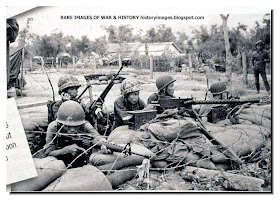A South Vietnamese soldier handles a corpse. 1966 (Image by Christian Simonpietri)
These men were soldiers. They were unfortunate. They fought for a country that ceased to exist, gobbled up by a aggressive brethren. They fought for a regime that was dictatorial and unpopular.
When America dumped South Vietnam and the communist North took over, no one shed any tears for these men of the ARVN (also called SVA- South Vietnamese Army). They lived and live in disgrace in Vietnam.
Their situation is not dissimilar to the soldiers of Waffen SS. Only that the world forgot soldiers of a country called South Vietnam.
A South Vietnamese soldier with a American made M 16 rifle
South Vietnamese soldiers with arms seized from the North Vietnamese (NVA) soldiers
SVA soldiers with flags captured from the communist NVA
 |
| South Vietnamese soldiers defend a village during the Tet Offensive |
 |
| South Vietnamese soldiers fighting on the streets of Saigon during the Tet Offensive in 1968.
|
 |
| A SVA soldiers takes an injured villager to safety. The regime was lousy but the SVA men came from the country and loved it |
 |
"Liberation" of Hue on Chinese New Year 1968 by by the NVA. Thousands of people, army, ARVN officers, the clergy. Catholics in Hue were killed, or buried alive.
BATTLE OF HUE
The Battle of Huế during 1968, was one of the bloodiest and longest battles of the Vietnam War (1959–1975). The Army of the Republic of Vietnam and three understrength U.S. Marine Corps battalions attacked and defeated more than 10,000 entrenched People's Army of Vietnam (PAVN) and National Front for the Liberation of South Vietnam (NLF, also known as, Viet Cong) guerrilla forces.
With the beginning of the Tet Offensive on January 30, 1968, the Vietnamese lunar New Year, large conventional American forces had been committed to combat upon Vietnamese soil for almost three years. Highway One passed through Hué and over the Perfume River (the river ran through the city dividing it into both northern and southern areas) creating an important supply line from the coastal city of Da Nang to the DMZ for the Allied forces. Hué was also a base for United States Navy supply boats.
The city, considering its value and its distance from the DMZ (only 50 kilometres (31 mi)), should have been well-defended, fortified, and prepared for any communist attack.
However, the city had few fortifications and was poorly defended. The South Vietnamese Army and U.S. Army forces were completely unprepared when the North Vietnamese army and Viet Cong failed to observe the promised Tet Truce. Instead, the Viet Cong and the North Vietnamese Army launched a massive assault throughout South Vietnam, attacking hundreds of military targets and population centers across the country, among them the city of Hué.
The North Vietnamese forces rapidly occupied most of the city. Over the next month they were gradually driven out during intense house-to-house fighting led by the Marines. In the end, although the Allies declared a military victory, the city of Hue was virtually destroyed and more than 5000 civilians were killed, more of them executed by the PAVN and Viet Cong (according to the South Vietnamese government). The North Vietnamese forces lost an estimated 2,400 to 8,000 killed, while Allied forces lost 663 dead and 3,707 wounded.
The tremendous losses negatively affected the American public's perception of the war and political support for the war began to wane.
|

Street in Saigon. 1968. South Vietnamese soldiers during the Tet Offensive.
Tan Son Nhut Air Base (1955–1975) was a Republic of Vietnam Air Force (VNAF) facility. It is located near the city of Saigon in southern Vietnam. The United States used it as a major base during the Vietnam War (1959–1975), stationing Army, Air Force, Navy, and Marine units there. Following the Fall of Saigon it was taken over as a Vietnam People's Air Force (VPAF) facility and remains in active use today.
SVA soldiers pass the corpses of Vietnamese people killed by the communists.
A SVA soldier looks after a wounded woman during the Tet Offensive
SVA soldiers with captured Vietcong. Propaganda? May be.
Former SVA men now POW escorted by a North Vietnamese soldier
THE FATE OF THE UNFORTUNATE SOLDIERS OF SOUTH VIETNAM
Once proud soldiers, they lived in utter poverty and disgrace under the new dispensation. They were soldiers. They were our allies against communism. They deserved better. They deserve the same respect as a American Vietnam Veteran.





















